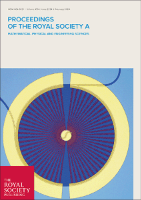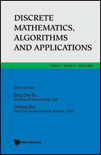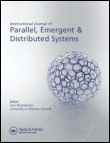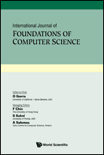
Journal of Cellular Automata
Scope & Guideline
Cultivating Insights in Control and Systems Engineering
Introduction
Aims and Scopes
- Theoretical Foundations of Cellular Automata:
Research in this area delves into the mathematical properties, classifications, and behaviors of cellular automata. This includes studies on universal cellular automata, rule complexity, and the dynamics of different cellular automata configurations. - Applications of Cellular Automata in Modeling:
The journal features works that utilize cellular automata for modeling complex systems, including simulations in biology, ecology, urban planning, and computer science. These applications demonstrate the versatility of cellular automata in real-world scenarios. - Algorithm Development and Computational Techniques:
Papers often explore new algorithms and methodologies for implementing cellular automata simulations, including enhancements for fault tolerance, error detection, and optimization techniques that improve the performance of cellular automata in computational tasks. - Interdisciplinary Approaches:
The journal encourages interdisciplinary research that applies cellular automata concepts to fields such as cryptography, social sciences, and physics, thereby expanding the scope and impact of cellular automata research.
Trending and Emerging
- Complex Systems and Interactions:
There is an increasing emphasis on using cellular automata to model complex systems with intricate interactions, such as public goods games and ecological dynamics. This trend illustrates a growing interest in understanding emergent behaviors from simple local rules. - Real-Time and Computational Efficiency:
Recent publications have focused on real-time generation and efficiency in cellular automata simulations, indicating a trend towards practical applications in computational environments, such as real-time data processing and interactive simulations. - Advanced Algorithmic Approaches:
Emerging themes include the development of advanced algorithms for enhancing cellular automata functionality, such as fault tolerance and genetic algorithms. This reflects a trend towards integrating cellular automata with cutting-edge computational techniques to solve complex problems. - Interdisciplinary Applications:
The journal is increasingly showcasing interdisciplinary research that applies cellular automata to diverse fields, including cryptography and urban planning. This trend indicates a broadening scope of cellular automata beyond traditional boundaries, fostering innovative applications.
Declining or Waning
- Traditional Game Simulations:
Earlier publications featured numerous studies on classic cellular automata games, such as Conway's Game of Life. However, recent issues indicate a shift towards more complex and varied applications, suggesting a waning interest in traditional game simulations. - Basic Rule Exploration:
Research focusing on the exploration of simple or basic rules of cellular automata appears to be declining. The recent trend shows a preference for more sophisticated and multi-rule systems, which indicates a move towards exploring complex interactions rather than foundational rule sets. - Static Cellular Automata:
Studies centered on static or non-dynamic cellular automata have decreased in frequency. The current research seems to favor dynamic systems that exhibit temporal changes and adaptability, suggesting a diminishing focus on static models.
Similar Journals

PROCEEDINGS OF THE ROYAL SOCIETY A-MATHEMATICAL PHYSICAL AND ENGINEERING SCIENCES
Unveiling Insights at the Intersection of Science and Engineering.PROCEEDINGS OF THE ROYAL SOCIETY A-MATHEMATICAL PHYSICAL AND ENGINEERING SCIENCES is a prestigious academic journal published by the Royal Society in the United Kingdom, dedicated to the dissemination of high-quality research in the fields of Mathematics, Engineering, and Physics. With an esteemed impact factor and ranked in the top quartiles (Q1) across various categories, this journal stands out as a leading source of innovative findings and critical discussions within the global scientific community. Researchers benefit from its comprehensive coverage that spans from theoretical explorations to practical applications, and the journal plays a crucial role in advancing knowledge and fostering interdisciplinary collaboration. Although it does not currently offer Open Access options, its influence is underscored by notable Scopus rankings, evidencing its significant contribution to the fields it represents. Located at 6-9 Carlton House Terrace, London SW1Y 5AG, England, the journal continues to be a cornerstone for scholars seeking to publish impactful research and stay informed on the latest advancements in science and engineering.

International Journal of Unconventional Computing
Unleashing the Potential of Unconventional ComputationThe International Journal of Unconventional Computing, published by OLD CITY PUBLISHING INC, is a pivotal platform for innovative research within the field of Computational Science. With a significant focus on unconventional computing methods, this journal aims to explore new paradigms and approaches that challenge traditional computational models. Launched in 2008 and running through 2024, it has established itself as a noteworthy publication in its domain, currently categorized in the Q3 quartile for Computer Science (miscellaneous). While it holds a Scopus rank of #143 out of 232 in General Computer Science, the journal continues to attract submissions from a diverse range of scholars—fostering a rich dialogue on cutting-edge developments. As an essential resource for researchers, students, and professionals eager to delve into pioneering computing techniques, this journal invites the global academic community to contribute and engage with its content. Access options vary, promoting flexibility for readers interested in exploring unconventional methodologies in computing.

DISCRETE EVENT DYNAMIC SYSTEMS-THEORY AND APPLICATIONS
Transforming Ideas into Applications in Discrete Event DynamicsDISCRETE EVENT DYNAMIC SYSTEMS – THEORY AND APPLICATIONS, published by SPRINGER, is a premier journal dedicated to advancing the field of discrete event systems and their applications across various domains. With a distinguished Q1 ranking in Control and Systems Engineering, Electrical and Electronic Engineering, and Modeling and Simulation, this journal is at the forefront of research dissemination, offering a vital platform for scholars and practitioners alike. Covering a broad spectrum from theoretical foundations to practical implementations, the journal aims to foster innovative solutions, promote cutting-edge methodologies, and enhance understanding of dynamic systems. The journal encompasses a wide array of scholarly contributions, including original research articles, reviews, and case studies, while leveraging its prestigious standing to cater to its diverse readership of researchers, professionals, and students. Established in 1991, and continuing through 2024, DISCRETE EVENT DYNAMIC SYSTEMS remains a cornerstone for those interested in the complex interplay of systems dynamics, ensuring a significant impact in both academic and industrial sectors.

Natural Computing
Advancing Knowledge in Nature-Inspired AlgorithmsNatural Computing is a leading peer-reviewed journal published by Springer, focusing on the interdisciplinary study of natural computation methods and their applications across various domains. With an ISSN of 1567-7818 and an E-ISSN of 1572-9796, this journal has established itself as vital in the field of Computer Science Applications, as reflected in its esteemed Q2 quartile ranking and a Scopus rank of #358 among 817 journals, placing it in the 56th percentile. Based in the Netherlands, Natural Computing covers a diverse range of topics, including computational models inspired by natural systems, evolutionary algorithms, and swarm intelligence. Seeking to bridge the gap between theoretical research and practical applications, this journal serves researchers, professionals, and students by providing insights and advancements in the field. With a commitment to fostering innovation, Natural Computing aims to push the boundaries of understanding in computational methods inspired by nature, making it an essential resource for those looking to contribute to and stay updated within this dynamic area.

Complex Systems
Pioneering Research for Tomorrow's Complex ChallengesComplex Systems is a pivotal journal published by Complex Systems Publications Inc, specializing in the interdisciplinary field of complex systems science. With an ISSN of 0891-2513, it focuses on advancing the understanding of complex phenomena across various domains, including computer science and control engineering. Operating from the United States, this journal has established itself as a credible source with a current impact factor reflecting its relevance—ranking in the Q3 category for both Computer Science (miscellaneous) and Control and Systems Engineering as of 2023. Although it does not offer Open Access, Complex Systems aims to facilitate the exchange of cutting-edge research and innovative methodologies, making it indispensable for researchers, professionals, and students eager to explore and contribute to the field. With coverage spanning from 2012 to 2024, it strives to foster a deeper understanding of the principles governing complex systems, thus paving the way for future technological advancements and theoretical developments.

Eurasian Journal of Mathematical and Computer Applications
Innovating Solutions through Mathematical and Computational Research.Eurasian Journal of Mathematical and Computer Applications, published by the prestigious L N GUMILYOV EURASIAN NATIONAL UNIVERSITY in Kazakhstan, stands as a vital platform for researchers and professionals engaging in the fields of Applied Mathematics, Computational Mathematics, Computer Science Applications, Information Systems, Mathematical Physics, and Modeling and Simulation. With its ISSN 2306-6172 and E-ISSN 2308-9822, this academic journal aims to foster innovative research and facilitate knowledge transfer in these interdisciplinary domains. The journal, which converges its endeavors from 2013 to 2024, is currently ranked Q3 across its various categories in 2023, reflecting its growing influence and commitment to academic excellence. Despite its open access availability, the journal's dedication to quality research is evident as it attracts contributions that not only advance theoretical understanding but also address practical applications. With a supportive community of researchers in an increasingly important field, the Eurasian Journal of Mathematical and Computer Applications is poised to remain a significant resource for those seeking to propel the boundaries of mathematical and computational sciences.

Journal of the Royal Society Interface
Connecting Ideas, Catalyzing ChangeJournal of the Royal Society Interface is a premier interdisciplinary journal dedicated to the convergence of life sciences, physical sciences, and engineering. Published by the esteemed Royal Society in the United Kingdom, this journal serves as a dynamic platform for innovative research that pushes the boundaries of both fundamental and applied science. With a significant impact factor and ranked in the prestigious Q1 category across multiple domains, including Biochemistry, Bioengineering, and Biomedical Engineering, the journal consistently prioritizes high-quality contributions that innovate and inspire. Accessible to researchers, professionals, and students alike, it aims to cultivate a deeper understanding of complex interactions and synergies among biological and physical systems. From its inception in 2004 to its evolving knowledge contributions through 2024, the Journal of the Royal Society Interface plays a pivotal role in shaping future research directions and fostering collaboration across scientific domains.

Discrete Mathematics Algorithms and Applications
Innovative Insights into Discrete Mathematics and Beyond.Discrete Mathematics Algorithms and Applications, published by World Scientific Publishing Co Pte Ltd, stands as a pivotal resource in the field of discrete mathematics and combinatorics since its inception in 2009, with a convergence period extending to 2024. The journal holds an esteemed position within its category, ranked in the Q3 quartile according to latest metrics, recognized for its qualitative contributions to the academic community. With an ISSN of 1793-8309 and an E-ISSN of 1793-8317, it serves as a vital conduit for disseminating innovative research focused on algorithms and their applications within discrete mathematics. Although currently not an open access journal, it provides access to valuable insights and findings that are crucial for researchers, professionals, and students seeking to advance their understanding and application of discrete mathematical concepts. Based in Singapore, the journal continues to promote rigorous scholarly discourse and is a key publication for those involved in advancing the discipline.

International Journal of Parallel Emergent and Distributed Systems
Unveiling the Future of Distributed Systems and Emergent ParadigmsInternational Journal of Parallel Emergent and Distributed Systems, published by Taylor & Francis Ltd, is a prestigious academic journal aimed at advancing the fields of parallel computing, distributed systems, and emergent technologies. With an ISSN of 1744-5760 and E-ISSN 1744-5779, this journal has been a vital resource for researchers and professionals since its inception in 2005. As a part of the Q3 category in Computer Networks and Communications and Q4 in Software, it reflects a growing interest and engagement in these critical areas of study, with Scopus rankings highlighting its significance in computer science. Although currently not an open-access journal, its comprehensive exploration of innovative methodologies, systems design, and distributed computing paradigms makes it essential reading for anyone involved in cutting-edge research and application development. The journal not only aims to disseminate novel insights but also serves as a platform to foster dialogue among practitioners and scholars alike, making it a cornerstone in the academic landscape of emergent technologies.

INTERNATIONAL JOURNAL OF FOUNDATIONS OF COMPUTER SCIENCE
Building the Future on Solid Computational FoundationsThe International Journal of Foundations of Computer Science, published by World Scientific Publishing Co Pte Ltd, is a premier repository for cutting-edge research in the field of computer science, emphasizing foundational theories and methodologies. With an ISSN of 0129-0541 and an E-ISSN of 1793-6373, this journal has established itself as a valuable resource since its inception in 2000, continuously contributing to scholarly discourse up to the present year, 2024. It is ranked in the Q2 quartile of computer science categories, indicating its notable impact and relevance within the academic community, particularly in miscellaneous subsections of the field. While it does not currently offer open access options, it remains a crucial platform for researchers, professionals, and students seeking to deepen their understanding of computational foundations, algorithms, and theoretical frameworks. The journal encourages submissions that push the boundaries of knowledge and invites innovative approaches that address contemporary challenges in computer science.